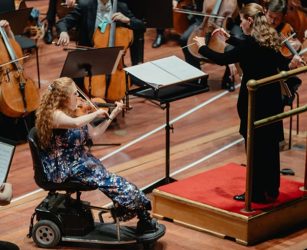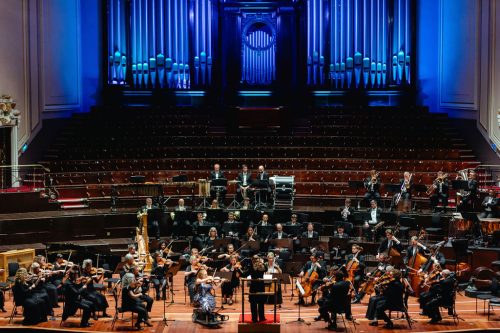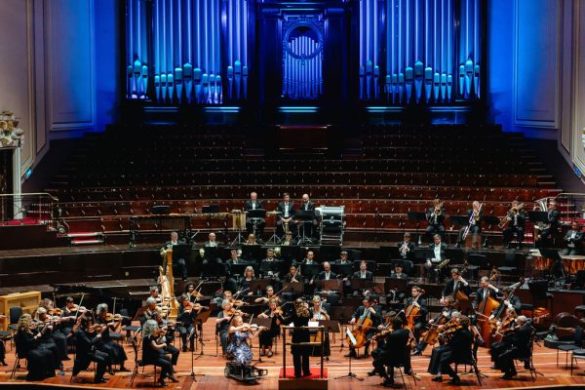 United Kingdom Copland, Price and Sibelius: Rachel Barton Pine (violin), Royal Scottish National Orchestra / Kristiina Poska (conductor). Usher Hall, Edinburgh, 27.10.2023. (TM)
United Kingdom Copland, Price and Sibelius: Rachel Barton Pine (violin), Royal Scottish National Orchestra / Kristiina Poska (conductor). Usher Hall, Edinburgh, 27.10.2023. (TM)

Copland – Appalachian Spring Suite
Florence Price – Violin Concerto No.2
Sibelius – Symphony No.1 in E minor, Op. 9
Although the most recent work on this weekend’s Royal Scottish National Orchestra programme dates from 1952, audiences are still just beginning to make its acquaintance. The ongoing reappraisal of the twentieth-century African American composer Florence Price would not be possible without the contributions of performers who have championed her music. For her guest appearance with the RSNO, Rachel Barton Pine, among the most passionate of these advocates, made Price’s Second Violin Concerto not only a topic of discovery but a revelation. Joining her in the endeavour was the Estonian conductor Kristiina Poska in her debut with the orchestra.
In fact, this wasn’t the acclaimed violinist’s first time performing the work with the RSNO. She recorded it with these musicians (under Jonathon Hayward) to include in the updated, 25th-anniversary edition of her landmark release Violin Concertos by Black Composers through the Centuries, which appeared last year. But Pine’s first live performance of the concerto at Usher Hall brimmed with so much poetry and conviction that the audience must have wondered why this music hasn’t already established itself as a staple of the American orchestral repertoire.
The reasons encompass the racism and sexism that were Price’s lot, as well as historical shifts in aesthetic priorities. Pine and her colleagues are, moreover, trying to make up for more than a half-century lost to oblivion, during which the concerto and several other major works by Price were thought to have been lost. It was only thanks to its chance discovery in 2009 among a trove of her manuscript scores in a dilapidated house that the Second Violin Concerto could be introduced to contemporary audiences. Pine describes the phenomenon of suddenly having this music become available for performance as ‘a dream come true’.
Indeed, the violinist lent a highly personal touch to her interpretation of the concerto, a work of late vintage (written the year before Price’s death at the age of 66) that unfolds in a single movement. Often rhapsodic in character, the music meanders between its two main ideas as if approaching them from varying angles. Pine coaxed a delightful variety of sound characters from her 1742 ‘ex-Bazzini ex-Soldat’ Guarneri del Gesu — in particular, a fine-grained eloquence in the lower range that intensified the focus on moments of introspective intimacy.
The presence of Romantic tropes is more enigmatic in this piece than in Price’s earlier works. Weaving in whole-tone harmonies, she turns away from the idea of the concerto as a dialectic struggle of the solo protagonist in favour of a kind of sonic field painting absorbed in melodic, at times bardic, contemplation. Pine’s balletic tenderness, especially graceful in the solo part’s garlands of flowing triplets, emphasised its large-scale as well as local lyricism.
As a proud Chicagoan — the Arkansas-born Price’s later adopted city — Pine says she feels a special sympathy with the composer, evident in her prayerful phrasing of a gospel-flavoured refrain that orients the concerto’s journey. Poska was alert to Price’s prismatic, often original touches of orchestration, facilitating the dialogue between soloist and orchestra with a sure hand.

Pine’s choice of encore, Nathan Milstein’s transcription of the Mephisto Waltz No.1 by Franz Liszt, condensed a concerto’s worth of old-school virtuosity into a miniature framework. Selected in homage to the Halloween season, the piece resembled a thriller with its acrobatic high notes and daredevil pyrotechnics — all dispatched with a seeming effortlessness that left the audience catching its collective breath. Still later into the night, Pine could be seen indulging her love of Scottish fiddle playing as she dropped by Sandy Bell’s, a century-old pub frequented by fans of the folk music scene, for an impromptu session with local musicians.
Pine’s wonderfully persuasive account of the Price concerto, as it happened, was not the concert’s only revelation. The musical intelligence and sense of purpose that Kristiina Poska brought to the better-known works on the programme made it clear that this is a conductor to whom attention should be paid. Recently named new music director of the Orchestre Français des Jeunes, Poska will introduce herself to U.S.-American audiences in 2024 in appearances with the Minnesota Orchestra and the Oregon Symphony.
Aaron Copland’s concert suite arrangement of his ballet score Appalachian Spring — composed less than a decade before the Price concerto — can come across as musical comfort food of a predictable quality. But Poska led the musicians through each scene with the assurance of a seasoned film director. The slow-motion ‘establishment shot’ of suspended string harmonies that frame the piece glowed with warmth. Copland’s clean-sprung rhythms pushed the narrative ahead with unforced optimism, while the Shaker tune variations at the climax unfurled like pageant of American folk life.
Poska’s deeply involved account of Sibelius’s fin-de siècle debut as a symphonist turned the concert’s second half into an adventurous epic. Showing an obvious affinity with the Finnish composer — she has recorded the work with the Symphonieorkest Vlaanderen — the conductor relished the First Symphony’s air of self-discovery. She played up its timbral contrasts, abetted by characterful contributions from the RSNO’s woodwinds in particular. We were invited to admire Sibelius’s challenge to symphonic convention — the clarinet’s long soliloquy to open the work, the sudden guttering into silence of the outer movements, almost terrifying in its bleak fatalism — while at the same time appreciating his conversation with other masters of the genre.
The Andante proved, as usual, the most elusive part of the symphony, framed by a despairing lyricism that genuinely haunted, while the Scherzo exploded with defiant, roller-coaster energy and was at the same time shown to be a dazzling study in orchestration. Poska, whose rapport with the RSNO was palpable, traced a through line in the finale that echoed questions from earlier in the piece and posed them anew, refusing to settle for easy answers.
Thomas May
Thomas May is a writer, critic, educator and translator whose work appears in The New York Times, Gramophone, and many other publications. The English-language editor for the Lucerne Festival, he also writes program notes for the Ojai Festival in California.
